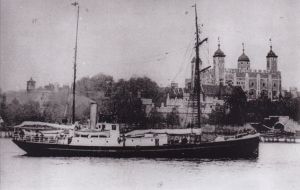MercoPress. South Atlantic News Agency
Shackleton “Quest” cabin, new show piece for South Georgia Museum
 The “Quest” passing on the Tower on London
The “Quest” passing on the Tower on London The cabin in which British polar explorer Sir Ernest Shackleton died aboard his ship “Quest” looks set to become an important new artefact at the South Georgia Museum.
The cabin was removed from the vessel a few years after the expedition and has been in Norway ever since, reports the January edition of South Georgia Newsletter.
“Quest” was originally built in Norway in 1917 as a sealing vessel called “Foca II”. A few years later Shackleton bought it for his forthcoming expedition and had it refitted at Southampton, UK. A new-deck house was added to make extra cabin space, including one for Shackleton and one for the ship’s captain.
There are good records of what the cabin used to be like. It was Scout Marr's daily task to “scrub out the boss's cabin” aboard “Quest”.
In his book 'Into the Frozen South' he gives the following description of Shackleton's cabin: “Don't, please, carry away...an impression of a sumptuous state-room. This sea-bedroom was little better than a glorified packing-case; it measured seven feet by six, and when you were in you felt half-afraid to draw a full breath in case you carried something away or burst the bulkhead apart. The door of this cabin opened onto the after-side; and on the port side was the bunk, stretching the entire length of the room, with drawers beneath and a single porthole above. A small washstand stood against the forward bulkhead; shelves well-fitted with books on the starboard side, and a small, collapsible chair completed the more elaborate furnishings...in addition, fixed to the forrard bulkhead, and were a small white-enamelled cabinet fitted with an oval mirror in the door, and an emergency oil-lamp for use when the electric supply gave out. That's as good a description as I can give of this tabloid apartment, where you could do everything humanly possible without leaving one spot!”
The cabin leaked badly in rough seas and at times Shackleton had to abandon it to sleep on a wardroom settee. The expedition was en route to the Antarctic when they called in at King Edward Cove where Shackleton died in his cabin on January 5th 1922.
The expedition continued despite the loss of its leader, returning to London later that year. Afterwards “Quest” was sold to Ludolf Schelderup, a Norwegian sealer, and refitted in 1924 at the Rognan shipyard in Norway. The deck-house was removed, taken ashore, and split up for use in various locations as summerhouses, storage sheds etc. The section that formed Shackleton’s cabin was kept by the re-fitter Johan Drage at his farm.
In 1980 the cabin was given to the local museum in Saltdalen. It was restored and opened to the public, however in recent years it has been somewhat neglected and has not been on show.
Last year Stig-Tore Lunde of South Georgia Heritage Trust (SGHT) Norway became aware of the important artefact's presence in Saltdal. He made contact with the original donor of the cabin, Ulf Bakke, and the Saltdal Museum and Saltdal Kommune (the municipality). In November 2009 all parties agreed that the cabin could be transported to Grytviken to become part of the South Georgia Museum.
The process of returning the cabin to South Georgia has already started. On January 21st the cabin was transported to Sandefjord, Norway, where it will be restored. Hopes are that the cabin will then be transported to South Georgia in the 2011-12 season.
You can see the SGHT’s report about this important artefact and donate towards the successful conclusion of this project on the SGHT website here.

Top Comments
Disclaimer & comment rulesCommenting for this story is now closed.
If you have a Facebook account, become a fan and comment on our Facebook Page!